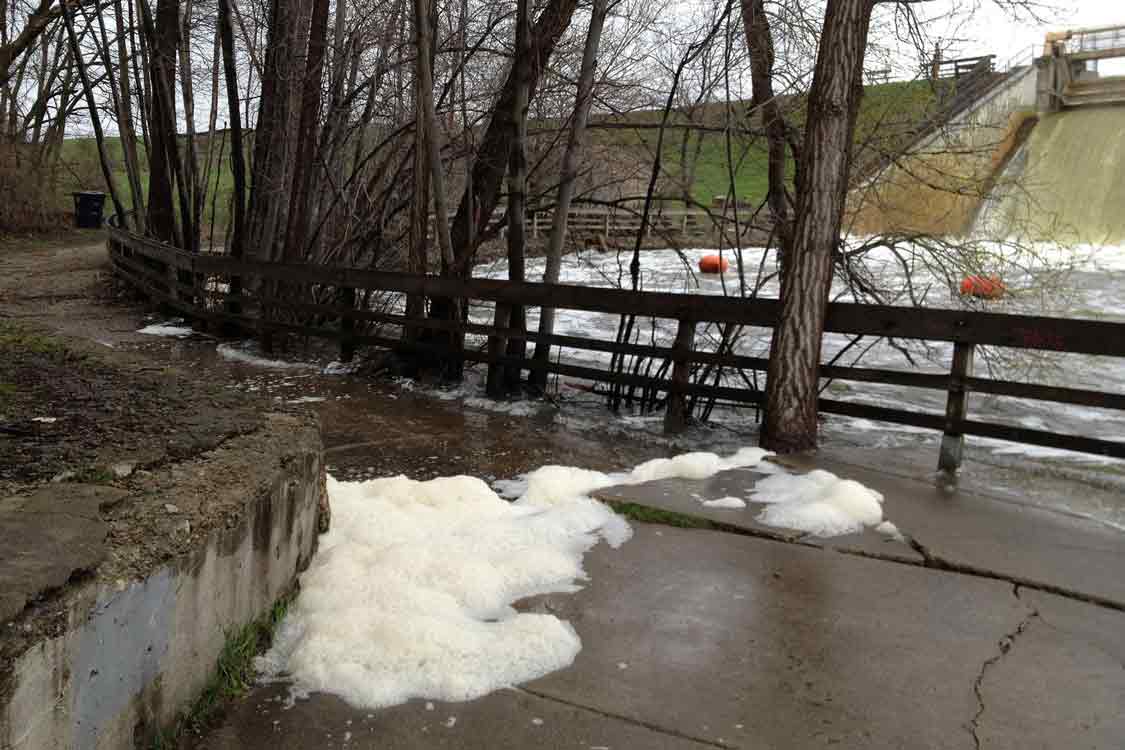PFAS in Foam on the Huron River Water Trail
As the emerging threat of PFAS has unfolded across Michigan and on the Huron River, it’s raised concerns about recreation.
Swimming, bathing, and boating on the Huron River Water Trail are still okay. For those activities, continue to enjoy the water as you have with a few minor precautions. PFAS isn’t

Photo of foam from 2013 that possibly contains PFAS, near Barton Dam, Ann Arbor, by Rebecca Foster.
a health risk when exposed to skin. The risk is that high levels of PFAS in foam can get on your hands and clothes and eventually make it into your mouth or nose. It’s a health risk when ingested over time, so accidental mouthfuls of river water are no cause for concern. The State of Michigan has issued a Do Not Eat Fish advisory for the Huron River and an advisory to avoid ingesting river foam.
PFAS tends to concentrate in foam and can lead to foam forming on the river, but foam is also naturally occurring. State experts and resources describe PFAS foam as bright white, sticky, lightweight, and that it tends to pile up near the water’s edge. Other harmless substances can create similar foam, however, and there’s really no practical way to know how much PFAS is in any glob of foam just by looking at it. It’s best to play it safe and treat all foam on the river as potentially containing high levels of PFAS. If you find foam you suspect is not naturally occurring, call the state’s 24-hour pollution hotline at (800) 292-4706.
Enjoy the River While Protecting Yourself from PFAS Foam
- Have fun swimming and boating on the river away from foam. Skin contact with river water or foam isn’t a concern. Accidental mouthfuls of river water or no cause for alarm.
- Avoid foam on the Huron River or connected lakes and creeks. Avoid touching foam and make sure to keep pets and kids away from foam. PFAS tends to concentrate in foam.
- Foam naturally occurs on rivers and PFAS tends to concentrate in foam, but there’s no way to know how much PFAS is in any glob of foam just by looking at it. It’s best to play it safe and treat all foam on the river as potentially containing high levels of PFAS.
- Although it feels nice on a hot summer day, don’t linger in the spray immediately below dams. It may be possible to inhale PFAS attached to foam spray.
- Wash your hands with soap and water and rinse off once you get home from paddling or swimming in the river.
- Rinse off pets if they made contact with foam or foamy water. Rinsing off in the same river or lake where foam isn’t present is okay.
For more information on PFAS in the Huron River watershed, visit the Huron River Watershed Council’s webpage at HRWC.org/PFAS.


